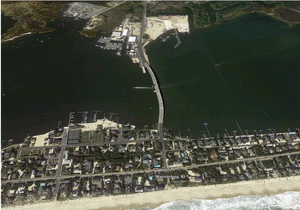
Above: dramatic photos from before and after Hurricane Sandy.
Below: Time-lapse video of the Hurricane from satellite.
Middle and High School … from a Montessori Point of View
What could possibly go wrong?
— Kai Ryssdal (2011) in Freakonomics: Preventing a hurricane on Marketplace by American Public Radio.
In what one can only hope is an extremely tongue-in-cheek article, Marketplace discusses how we might geoengineer a solution to stop hurricanes forming.
Hurricanes get their energy from the warm surface waters in the tropics. The warm water evaporates, transferring heat from the oceans to the atmosphere as latent heat in the form of water vapor. As the air rises, the water vapor condenses to form water droplets (clouds) releasing the stored heat into the air, causing the air to rise faster, sucking up more moisture, and setting up a positive feedback loop that turns storms and hurricanes.
But they need a constant supply of warm water.
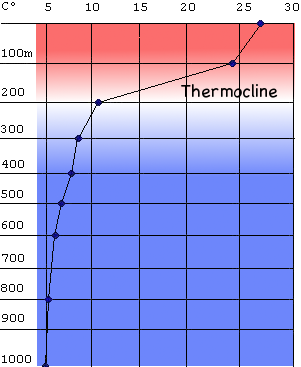
Unfortunately for the storms, the warm water in the tropics is only a thin layer, a couple of hundred meters deep, that sits above about 3,000 meters of colder deep-water. As the storms suck up the heat and moisture, they stir the oceans, cooling down the surface water, and leaving cooler water in their wakes. The cooler water means that subsequent storms have access to less energy.
The energy in the atmosphere and oceans “wants” to distribute itself evenly over the surface of the Earth. Hurricanes are just one violent means of moving heat from the tropics to the poles, and from the surface to the depths of the oceans.
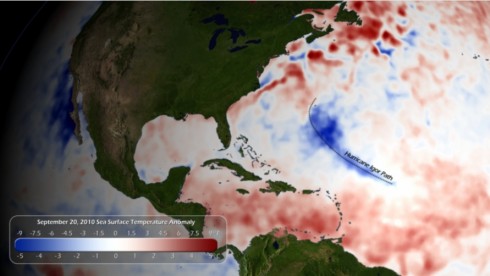
NOAA’s National Hurricane Center monitors sea-surface temperatures closely: it’s one of the key factors that go into their predictions of how bad the hurricane season is going to be, and what path a storm might take.
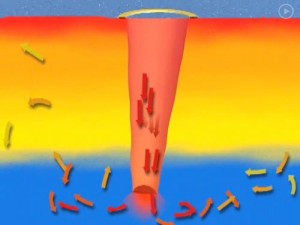
The suggestion in the Marketplace article is that we could build about 10,000 long tubes (called Salter Sinks) to connect the warm shallow surface water to the colder water below the thermocline. Wave energy at the surface would drive the warm water downward, causing mixing that would reduce the temperature of the surface water the storms feed off.
The devices might cost tens of millions of dollars per year, but that would be a lot less than the cost in property damage alone of a large storm like Irene, not to mention the loss of life it would prevent.
Apart from the “benign” environmental impact (according to Stephen Dubner) the only real question left is:
What could possibly go wrong?
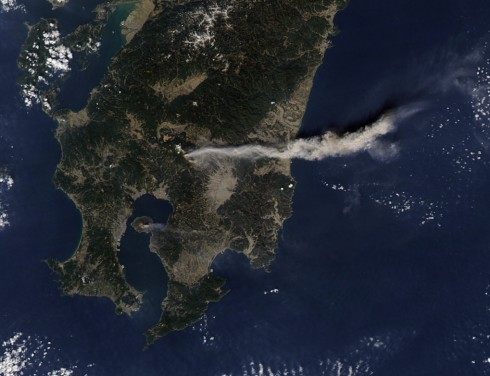
The Shinmoedake Volcano erupted on January 19th after being dormant for two years, however, two days after the big Japanese earthquake, it began spewing ash once again. The two are not necessarily connected.
Volcanos and convergent margins go together. Typically, the plate being subducted melts as it is pushed deeper into the Earth and temperatures rise. It also helps that the water in the crust and sediment of the subducting plate makes it easier to melt, and makes the resulting magma much more volatile and explosive.
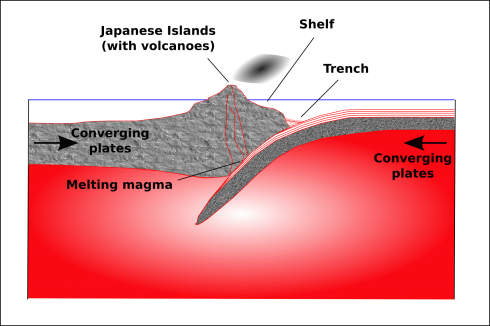
But although Shinmoedake is in Japan, it is not on the same tectonic boundary as the earthquake. The northern parts of Japan are where the Pacific Plate is being subducted beneath the Okhotsk Plate. This volcano is connected to the subduction of the Philippine Plate to the south.
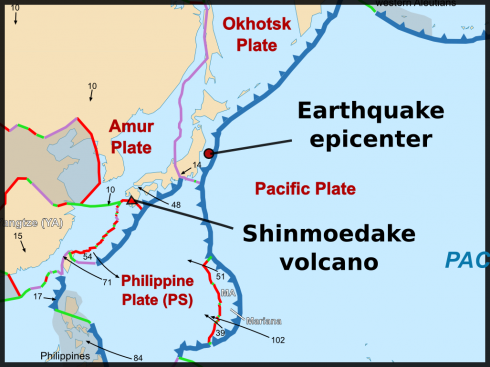
This does not necessarily mean that the two occurrences are totally unrelated. Seismic waves from the big earthquake could have been enough to incite magma chambers that were just about ready to blow anyway.
The map below is centered on the series of craters in the region of the erupting volcano.
The tsunami spawned by the recent earthquake off Japan did most of the damage we know about so far. The U.S. National Oceanic and Atmospheric Administration’s Center for Tsunami Research uses computer models to forecast, and provide warnings about, incoming tsunami waves. They have an amazing simulation showing the propagation of the recent tsunami across the Pacific Ocean (the YouTube version is here).
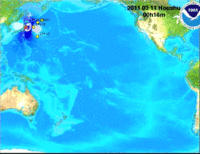
They’ve also posted an amazing graphic showing the wave heights in the Pacific Ocean.
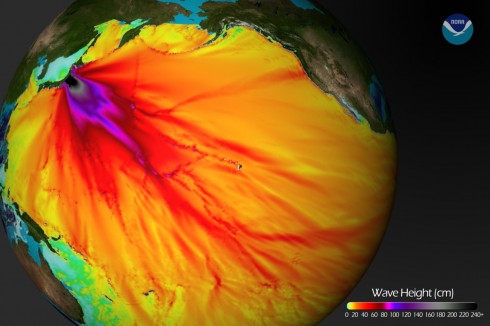
Of course, these are the results of computer simulations. As scientists, the people at NOAA who put together these plots are always trying to improve. Science involves a continuous series of refinements to better understand the world we live in, so the NOAA scientists compare their models to what really happen so they can learn something and do better in the future. Perhaps the best way to do this for the tsunami is by comparing the predictions of their models to the actual water height measured by tidal gages:

You’ll notice that NOAA did not do a perfect job. They did get the amplitude (height) of the waves mostly right, but their timing was a little off. Since it’s about 6000 km from the earthquake epicenter to Honolulu, being off by a few minutes is no mean feat. Yet I’ll bet they’re still working on making it better, particularly since some of the other comparisons were not quite as good.
Finally, if you were wondering, attempting to surf a tsunami is not a good idea. For one thing, there is no nice face to surf on:
… a tsunami wave approaching land is more like a wall of whitewater. …. Since the wave is 100 miles long and the tail end of the wave is still traveling at 500 mph, the shore end of the wave becomes extremely thick, and is forced to run far inland, over streets and trees and houses. …. And remember, the water isn’t clean, but filled with everything dredged up from the sea floor and the land the wave runs over–garbage, parking meters, pieces of buildings, dead animals.
— Natural Hazards Hawaii, University of Hawaii at Hilo: Why you can’t surf a tsunami
UPDATE: Terrifying video of the tsunami:
CNN has an informative interview on the explosion at the Fukushima nuclear plant in Japan after the earthquake and tsunami.
Footage of the explosion from the BBC:
Nuclear disasters are so rare that they’re easy to forget about when we’re talking about the right mix of alternative (non-carbon based) energy sources for the future.
Right after the accidents at Three Mile Island in 1979 and Chernobyl in 1986, awareness of the dangers lead to a de facto moratorium on nuclear power plants in the U.S.. This was good in that people were now treating nuclear power much more respectfully, and incorporating the costs of potential accidents into their calculations. However, it also reduced the interest and effort of developing newer and safer types of nuclear plants.
We’ll have this discussion next year when we focus more on the physical sciences.
UPDATE:
1. More details on how nuclear plants work can be found in Maggie Koerth-Baker’s post, Nuclear energy 101: Inside the “black box” of power plants.
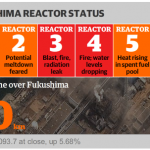
2. The Guardian’s live blog has good, up-to-date information on the status of the nuclear reactors at Fukushima.
The magnitude 8.9 earthquake that devastated coastal areas in Japan shows up very clearly on the United States Geologic Survey’s recent earthquake page.
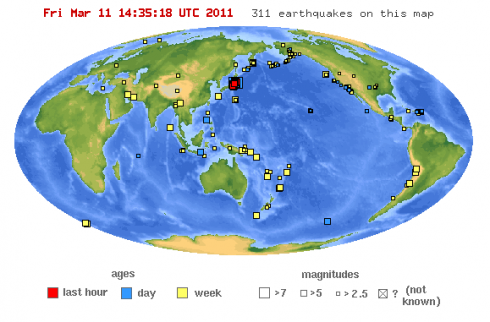
Based on our studies of plate tectonics, we can see why Japan is so prone to earthquakes, and we can also see why the earthquake occurred exactly where it did.
The obvious trench to the east and the mountains and volcanoes of the Japanese islands indicate that this is a convergent margin. The Pacific plate is moving westward and being subducted beneath the northern part of Japan, which is on the Okhotsk Plate.
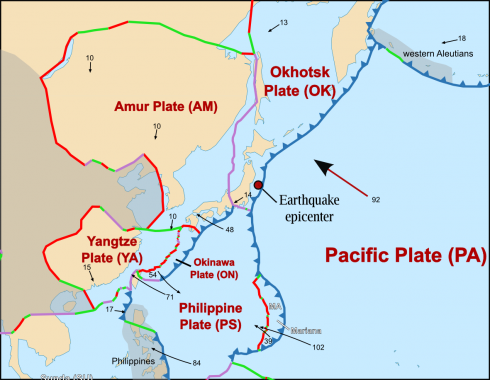
The epicenter of the earthquake is on the offshore shelf, and not in the trench. Earthquakes are caused by breaking and movement of rocks along the faultline where the two plates collide.
In cross-section the convergent margin would look something like this:
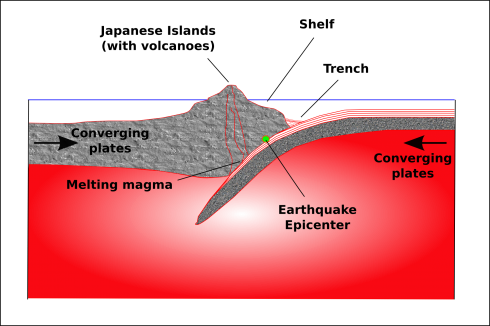
The shaking of the sea-floor from the earthquake creates the tsunamis.
So where are there similar tectonic environments (convergent margins)? You can use the Google Map above to identify trenches and mountain ranges around the world that indicate converging plates, or Wikimedia Commons user Sting’s very detailed map, which I’ve taken the liberty of highlighting the convergent margins (the blue lines with teeth are standard geologists’ markings for faults and, in this case, show the direction of subduction):

The Daily Dish has a good collection of media relating to the effects of the quake, including footage of the tsunami inundating coastal areas.
Cars being washed away along city streets:
Our thoughts remain with the people of Japan.
UPDATES:
1. Alan Taylor has collected some poignant pictures of the flooding and fires caused by the tsunami and earthquake. TotallyCoolPix has two pages dedicated to the tsunami so far (here and here).
2. Emily Rauhala summarizes Japan’s history of preparing for this type of disaster. They’ve done a lot.
3. Mar 12, 2011. 2:10 GMT: I’ve updated the post to add the map of the tectonic plates surrounding Japan.
4. A CNN interview that includes video of the explosion at the Fukushima nuclear power plant (my full post here).
5. NOAA has an amazing image showing the tsunami wave heights.

They also have an excellent animation showing the tsunami moving across the Pacific Ocean. (My post with more details here).
6. The United States Geological Survey (USGS) put out a podcast on the day of the earthquake that has interviews with two specialists knowledgeable about the earthquake and the subsequent tsunami, respectively. Over 250 kilometers of coastline moved in the earthquake which is why the tsunami was so big. They also have a shakemap, that shows the area affected by the earthquake.
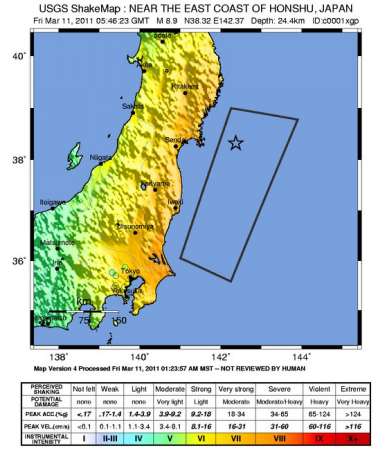
7. ABC News (Australia) and Google have before and after pictures.
8. The University of Hawaii has a page about, Why you can’t surf a tsunami.
9. A detailed article on earthquake warning systems, among which, “Japan’s system is among the most advanced”, was recently posted in Scientific American.
10. Mar 15, 2011. 9:15 GMT: I’ve added a map of tectonic boundaries highlighting convergent margins.
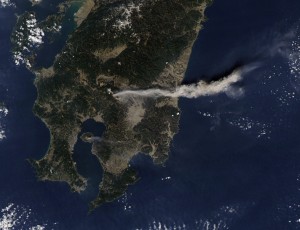
11. The Shinmoedake Volcano erupted two days after the earthquake, but they may be unrelated.

12. The Guardian’s live blog has good, up-to-date information on the status of the nuclear reactors at Fukushima.
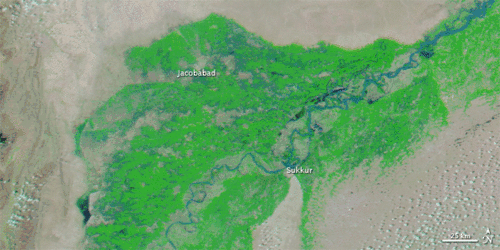
One of the largest natural disasters in history, the change in the landscape from the Pakistani flooding is astounding when viewed from space.
Images are from the area around Jacobabad in Pakistan.
[googleMap name=”Pakistani Sindh” description=”Flooding” width=”450″ height=”400″ mapzoom=”6″ mousewheel=”false” directions_to=”false”]Jacobabad[/googleMap]
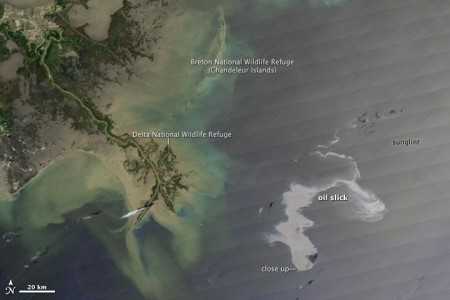
The scale of the disaster caused by the oil leaking into the Gulf of Mexico from the damaged oil rig is increasing day by day. We are preparing to go on the end-of-year adventure trip soon, but I’m wondering if students might be interested in heading down to the Gulf coast to volunteer in the clean-up.

NASA’s Earth Observatory has some amazing imagery on its page on the oil leak. Many of the images also show the mouth of the Mississippi and its delta, which tie directly into our observations in the sandbox. The impact of the oil spill also brings up the topic of density differences in fluids, something we’ve seen in the making bread jars, but applied to a much larger scale.